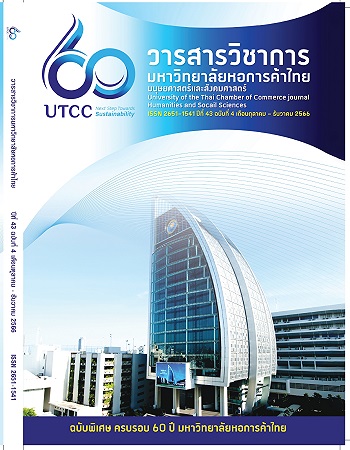A Study on Marketing Strategy of the Local Food Products in Nan Province for Competitiveness through Social Media Platform
Main Article Content
Abstract
This research aimed to study important influencing factors to competitiveness component of local food products through social media of marketing platform. The sample group comprised of 400 consumers were collected from questionnaires by using convenience sampling method. The data were analyzed by Confirmatory Factor Analysis to confirm the model’s goodness-of-fit and to test the hypotheses. The results found that 1) the competitiveness of local food products through social media of marketing platform in a statistically significant. The confirmatory factor analyses of model revealed 4 factors namely social media marketing, consumers trust, consumers perceived value, and competitiveness factors. The social media marketing factor consisted of 4 aspects including entertainment, interaction, trendiness, and customization. The consumers perceived value factors consisted of 4 aspects including reasonable price, product quality, functional value, and social value. The consumers trust factors consisted of 4 aspects including reliability, integrity, caring, and response. The competitiveness factors consisted of 4 aspects including finance, marketing, performance, and market size. 2) The results of secondary order confirmatory factor analyses revealed that 4 factors were equally important. The variables in this study were consistent with the empirical data (P-value = 0.268, c2/df = 1.100, CFI = 0.999, GFI = 0.978, AGFI = 0.954, RMSEA = 0.016, RMR = 0.002). These findings indicate the importance of social media marketing influencing consumers perceived value and enhancing the competitiveness of local food products through social media of marketing platform in Nan province.
Article Details

This work is licensed under a Creative Commons Attribution-NonCommercial-NoDerivatives 4.0 International License.
ลิขสิทธิ์ของบทความ
ผลงานที่ได้รับการตีพิมพ์ถือเป็นลิขสิทธิ์ของมหาวิทยาลัยหอการค้าไทย ห้ามมิให้นำเนื้อหา ทัศนะ หรือข้อคิดเห็นใด ๆ ของผลงานไปทำซ้ำ ดัดแปลง หรือเผยแพร่ ไม่ว่าทั้งหมดหรือบางส่วนโดยไม่ได้รับอนุญาตเป็นลายลักษณ์อักษรจากมหาวิทยาลัยหอการค้าไทยก่อน
References
กริช แรงสูงเนิน. (2554). การวิเคราะห์ปัจจัยด้วย SPSS และ AMOS เพื่อการวิจัย. กรุงเทพฯ: ซีเอ็ดยูเคชั่น.
สำนักงานพัฒนาธุรกรรมทางอิเล็กทรอนิกส์. (2564). ETDA เผยมูลค่าอีคอมเมิร์ซไทย ปี 63 อยู่ที่ 3.78 ล้านล้านบาท คาดปี 64 พุ่งไปที่ 4.01 ล้านล้านบาท. สืบค้นเมื่อ 28 มกราคม 2565, จาก https://www.etda.or.th/th/pr-news/ETDA-Reveals-the-Value-of-e-Commerce-in-2021.aspx
สำนักงานส่งเสริมวิสาหกิจขนาดกลางและขนาดย่อม. (2563). รายงานสถานการณ์ MSME ปี 2563. สืบค้น เมื่อ 6 มีนาคม 2565, จาก https://www.sme.go.th/en/download.php?modulekey=215
Alkraiji, A., & Ameen, N. (2022). The impact of service quality, trust, and satisfaction on young citizen loyalty towards government e-services. Information Technology & People, 35(4), 1239-1270. doi:10.1108/ITP-04-2020-0229
Alonso-Dos-Santos, M., Alguacil Jiménez, M., & Carvajal-Trujillo, E. (2020). Facebook commerce usage intention: A symmetric and asymmetric approach. Information Technology & Management, 21(3), 145-156. doi:10.1007/s10799-019-00311-2
Barney, J. B. (2001). Resource-based theories of competitive advantage: A ten-year retrospective on the resource-based view. Journal of Management, 27(6), 643-650. doi:10.1177/014920630102700602
Chen, H., Chen, H., & Tian, X. (2022). The impact of social shopping feature richness on buying intention: A product perspective. Internet Research, 32(4), 1378-1400. doi:10.1108/INTR-05-2021-0313
Concha-Meyer, A., Durham, C. A., Colonna, A., Hasenbeck, A., Sáez, B. A., & Adams, M. R. (2019). Consumer response to tomato pomace powder as an ingredient in bread: Impact of sensory liking and benefit information on purchase intent. Journal of Food Science, 84(12), 3774-3783. doi:10.1111/1750-3841.14932
Cronbach, L. J. (1970). Essentials of psychological testing (3rd ed.). New York, NY: Harper & Row.
Dabbous, A., Barakat, K. A., & DeQuero-Navarro, B. (2022). Fake news detection and social media trust: A cross-cultural perspective. Behaviour & Information Technology, 41(14), 2953-2972. doi:10.1080/0144929X.2021.1963475
Dwivedi, Y. K., Ismagilova, E., Hughes, D. L., Carlson, J., Filieri, R., Jacobson, J., … Wang, Y. (2021). Setting the future of digital and social media marketing research: Perspectives and research propositions. International Journal of Information Management, 59(1), 102168. doi:10.1016/j.ijinfomgt.2020.102168
Hariguna, T., Rahardja, U., & Ruangkanjanases, A. (2020). The impact of citizen perceived value on their intention to use e-government services: An empirical study. Electronic Government: An International Journal, 16(4), 426-440. doi:10.1504/EG.2020.110609
Hou, J.-R., & Kankham, S. (2022). More than feelings? How Facebook reaction icons affect online users’ behavioral intentions toward online health rumor posts. Internet Research, 32(6), 1978-2002. doi:10.1108/INTR-04-2021-0236
Jin, X., & Xu, F. (2021). Examining the factors influencing user satisfaction and loyalty on paid knowledge platforms. Aslib Journal of Information Management, 73(2), 254-270. doi:10.1108/AJIM-07-2020-0228
Laor, T., & Lissitsa, S. (2022). Mainstream, on-demand and social media consumption and trust in government handling of the COVID crisis. Online Information Review, 46(7), 1335-1352. doi:10.1108/OIR-06-2021-0299
Li, L., Long, X., Laubayeva, A., Cai, X., & Zhu, B. (2020). Behavioral intention of environmentally friendly agricultural food: The role of policy, perceived value, subjective norm. Environmental Science and Pollution Research, 27(15),18949-18961. doi:10.1007/s11356-020-08261-x
Morgan, A. N., Vorhies, D. W., & Schlegelmilch, B. B. (2006). Resource–performance relationships in industrial export ventures: The role of resource inimitability and substitutability. Industrial Marketing Management, 35(5), 621-633. doi:10.1016/j.indmarman.2005.05.018
Nejad, M. S., Harooni, J., Charkazi, A., Shams, M., & Latifi, M. (2021). Using social marketing to promote preventive behaviors related to COVID-19. Journal of Lifestyle Medicine,11(2), 52-56. doi:10.15280/jlm.2021.11.2.52
Roig, J. C. F., García, J. S., & Tena, M. Á. M. (2009). Perceived value and customer loyalty in financial services. The Service Industries Journal, 29(6), 775-789. doi:10.1080/02642060902749286
Rujjanawate, C., Kanjanapothi, D., Amornlerdpison, D., & Pojanagaroon, S. (2005). Anti-gastric ulcer effect of Kaempferia parviflora. Journal of Ethnopharmacology, 102(1), 120-122. doi:10.1016/j.jep.2005.03.035
Wijayanti, T. C., Kurniawan, D. A., Darma, D. C., & Hakim, Y. P. (2021). Evaluation on social media marketing from customers. Webology, 18(2), 598-615. doi:10.14704/WEB/V18I2/WEB18341
Yang, H., & Han, S.-Y. (2021). Understanding virtual reality continuance: An extended perspective of perceived value. Online Information Review, 45(2), 422-439. doi:10.1108/OIR-02-2020-0058
Yeik, K. K., Teoh, C. W., & Soh, P. C. H. (2021). Instagram influencer marketing: Perceived social media marketing activities and online impulse buying. First Monday, 26(9), 1-19. doi:10.5210/fm.v26i9.11598
Yenjai, C., Prasanphen, K., Daodee, S., Wongpanich, V., & Kittakoop, P. (2004). Bioactive flavonoids from Kaempferia parviflora. Fitotherapia, 75(1), 89-92. doi:10.1016/j.fitote.2003.08.017


